Cases of the coronavirus variant Pirola have tripled in two weeks, the Centers for Disease Control and Prevention (CDC) have said.
According to the latest data, Pirola made up 8.8 percent of cases as of November 25, triple the number the variant was linked to in the previous two-week period.
The Omicron BA.2.86 variant has earned the reclassification of “variant of interests” under World Health Organisation (WHO) standards.
The areas most affected by the Pirola variant are in the northeast of the United States, where it became the second most common variant after the one known as HV.1.
The CDC has however noted the Pirola variant, which has been the third-most prevalent one in the US since the summer, “does not appear to be driving increases in infections or hospitalisations.”
For all the latest on news, politics, sports, and showbiz from the USA, go to Daily Express US
Experts from the centres said the latest batch of FDA-approved vaccines should “increase protection against BA.2.86, as they do for other variants.”
Both Pfizer-BioNTech and Novavax said their updated shots offer some protection from Pirola and Moderna said its September trial also provided improved immunity.
The WHO and the CDC both agreed that “the public health risk posed by this variant is low compared with other circulating variants.”
In a statement, the CDC added that it is unclear whether the specific coronavirus variant caused different symptoms compared to other ones in circulation.
They said: “The types of symptoms and how severe they are usually depend more on a person’s immunity than which variant causes the infection.”
While scientists believe the Pirola variant poses no greater threat than others, International Development Group fellow Richard Reithinger, PhD, suggested at-risk individuals should consider resuming the use of face masks.
Reithinger argued the spike in coronavirus cases is the result of the US entering “COVID-19 season” and because Americans have so far developed non-Pirola immunity.
He told Fox News Digital that vulnerable people should consider wearing masks as well as ensuring they frequently wash their hands and avoid crowded areas.
The doctor added: “People — particularly those with greater risk of infection and severe disease — should continue to be sensitized and vigilant about COVID-19 and the disease it may cause.
“People who are at greater risk of infection and severe disease should consult with their physicians about whether they should be administered one of the currently available boosters.

